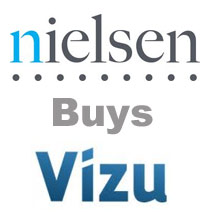 The search for a better understanding of a digital ad’s effectiveness remains hot.
The search for a better understanding of a digital ad’s effectiveness remains hot.
And with today’s purchase of Vizu, announced this morning, Nielsen says its clients will be able to measure their online branding campaigns in something like real-time. Not only that, Nielsen says it wants to help them optimize their audience buying efforts by plugging brand KPI campaign data back into the exchanges – old-hat for direct response campaigns, but still a somewhat revolutionary concept for upper funnel advertising.
The deal is also interesting in light of ComScore’s purchase of ad verification firm AdXpose (AdExchanger Q&A) last year, and that product’s inclusion in the Validated Campaign Essentials suite. Nielsen, too, is bringing Vizu’s brand metrics tool to bear on its own Brand Effect and Online Campaign Ratings products. The rival platforms both aspire to TV-like standardization of reach and frequency measurement, which have evolved over decades to serve the needs of brand advertisers.
The question now: How long will it take these increasingly cross-channel brand measurement systems to offer the responsiveness of the online medium? In this chat with AdExchanger, Nielsen’s Scott McKinley, EVP ad effectiveness, says the day is nigh.
AdExchanger: How does online branding optimization work through Vizu?
SM: We’re able to identify people in an online advertising campaign who’ve been exposed to advertising. While that campaign is running we find people who were in that target that weren’t exposed to advertising. We’re able to survey them with a very light touch poll, to determine whether the exposure to advertising has changed their attitudes and intentions toward that brand as measured by the key performance indicators for the campaign.
If the goal of the campaign is to raise awareness or intent to purchase, the Vizu system can tell us in near real-time if the campaign is working or not. It reports on that performance against sites, creatives, audiences, all the dimensions of the plan that a trafficker or a planner can use to optimize.
The optimization piece would appear to bring Nielsen more into the realm of services. A sign of things to come?
Absolutely, we think ad optimization is a big opportunity. With real-time bidding and programmatic buying, we watch them very closely. We think there’s an opportunity for brand advertisers to leverage those developments, which are traditionally used for direct marketing. Vizu gives us an amazing way to bridge that gap, so that one day a brand advertiser such as Tide, Pampers, or Nissan could use the existing tools to optimize against brand KPIs, not just direct response.
In terms of services, we made the decision some years ago to bring in a strong solutions layer to the company and not just provide data. This also feeds into our ability to report on cross-platform for advertisers.
How do you characterize the overall state of brand performance metrics for digital?
It’s been a challenge for the industry, going back to the beginning of the commercial Internet. Online has been great at direct response, almost too great. It’s almost like the better it got at direct response and optimizing against clicks, the more it distanced itself from what the brand advertiser wanted. Tools like Vizu enable digital to speak brand.
This is a logical step forward from a position we built last year around online campaign ratings, the first step in delivering reach metrics for the online channel that are comparable to television. We’ve got, for the first time, standard GRP reach metrics for digital that allow an advertiser to understand reach across digital and reach across platform, and now we’re layering the ability to measure effectiveness as well against brand KPIs.
It should begin to move the needle.
Yet it’s still hard to spend online in the same volume that is possible on TV. We often here measurement is the key to this puzzle, but does fixing that make it easier to spend?
What we’re talking about here is cross-platform comparability. That’s the cornerstone of the strategy. We don’t want to measure each medium separately, and report separately. To help that advertiser understand the role of each of these touch points against their brand objectives, it has to be a comparable story.
In terms of taking measurement into action, that’s where Vizu has done better than any other player. It can plug performance data coming directly out of a campaign in near real-time (I’m talking hourly) directly into the buying exchanges. It’s very exciting. A campaign can be optimized either manually through very fast cycle data or automatically through ad exchanges to change the outcome of a plan in flight based on brand performance data.
But it’s not going to be flipping a switch. Nothing ever is.
With a custom study to measure a single campaign, where you get a report after the campaign is over, it’s really hard to take action on that. That stuff’s generally just used to make sure you did your job.
The goal of Vizu is to take that data and put it into the hands of the folks who can change that plan on a daily and hourly basis, and also to plug it back into the exchanges to change the outcome of the campaign.
– By Zach Rodgers













